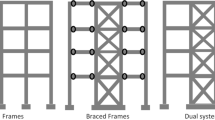Abstract
Due to the escalation of the prize of construction materials, Engineers are forced to reduce the construction cost in buildings by adopting various techniques. In this project, an attempt is made to reduce the cost of the buildings in the super structures, since 70% of the cost of the building has been spent on it. A comparison of detailed estimate for steel as well as concrete has been made. To make the building economical and structurally efficient, the traditional method of load-bearing walls has been avoided by adopting steel framed structure, since the cost of a reinforced concrete-framed structures is high because of the use of cement, sand, and aggregates. Most of the loads are not fully carried by concrete, and hence, the members are not efficient. For this reason, steel super structure is considered here. The optimization on the structural components has been done by adopting techniques like bracings, lightweight floor slabs, roof slabs, and partition walls which are analyzed and designed in ETABS. Generally, the bracings are the structural component that converts lateral load into axial force. Therefore, the moment on the structure has been reduced, and hence, the stability can be improved. As steel structures are prefabricated the assemblies of these systems require less time and environmental factors can also be avoided. The structure can be completed within the stipulated time based on the requirements of the client. Hence, the construction time can be reduced in addition to reduction in the cost of the building. The economical alternative among steel and reinforced concrete building can be analyzed by doing the cost estimation of the building.
Access this chapter
Tax calculation will be finalised at checkout
Purchases are for personal use only
Similar content being viewed by others
References
Jones, A., Stegemann, J., & Sykes, J. P. (2016). Winslow, adoption of unconventional approaches in construction: The case of cross-laminated timber. Construction and Building Materials, 125, 690–702.
European Commission. (2019). Final towards a circular economy: A zero waste programme for Europe COM 398 Final, 2014 (pp. 398). Available from: http://ec.europa.eu/transparency/regdoc/rep/1/2014/EN/1-2014-398-EN-F1-1.Pdf. Accessed February 25, 2019.
Mohammadi, J., & Ling, L. (2017). Can wood become an alternative material for tall building construction. Practice Periodical on Structural Design and Construction. https://doi.org/10.1061/(ASCE)SC.1943-5576.0000334
Ahmed, S., & Arocho, I. (2021). Analysis of cost comparison and effects of change orders during construction: Study of a mass timber and a concrete building project. Journal of Building Engineering, 33, 101856. https://doi.org/10.1016/j.jobe.2020.101856
Gagandeep. (2020). Time and cost comparison of reinforced cement concrete and steel structure. Materials Today: Proceedings. ISSN: 2214-7853. https://doi.org/10.1016/j.matpr.2020.08.672
John, S., & Buchanan, A. (2012). Cost and construction time for a 3-story post tensioned timber building compared with concrete and steel building. In Proceedings of the 2012 World Conference on Timber Engineering. Auckland, New Zealand.
Bockholta, M. T., Kristensen, J. H., Colli, M., Jensen, & Wæhrens, B. V. (2020). Exploring factors affecting the financial performance of end-of-life take-back program in a discrete manufacturing context. Journal of Cleaner Production, 258, 120916. https://doi.org/10.1016/j.jclepro.2020.120916
Zaveri, B. H., Gadhiya, J. A., & Dhameliya, H. K. (2016). A review on the comparative study of steel, RCC and composite building. International Journal of Innovative Science Engineering and Technology, 5.
Jirage, M., Sayagavi, V. G., & Gore, N. G. (2012). Comparative study of RCC and composite multi-storeyed building. International Journal of Applied Science and Engineering (IJSEAS), 1(6). ISSN: 2395-3470.
Krishna Raju, N. (2006). Reinforced concrete design. New Age International Pvt. Ltd.
Punmia, B. C. RCC designs. Laxmi Publications.
Dutta, B. N. (2002). Estimating and costing in civil engineering (25th ed.). UBS Publishers and Distributors Pvt. Ltd.
Chakraborti, M. (2006). Estimation, costing, specific and valuation in civil engineering (Kolkata ed.). M. Chakraborti Publisher.
Wang, M., Luo, D., & Hu, Z. (2020). Seismic performance of steel-enhanced damping concrete core walls with concealed steel plate bracings. Engineering Structures, 213. https://doi.org/10.1016/j.engstruct.2020.110564
Nassani, D. E., Hussein, A. K., & Mohammed, A. H. (2017). Comparative response assessment of steel frames with different bracing systems under seismic effect. Structures, 11, 229–242. https://doi.org/10.1016/j.istruc.2017.06.006
Safarizki, H. A., Kristiawan, S. A., & Basuki, A. (2013). Evaluation of the use of steel bracing to improve seismic performance of reinforced concrete building. Procedia Engineering, 54, 447–456. https://doi.org/10.1016/j.proeng.2013.03.040
Bhat, K. A., & Danish, P. (2021). Analyzing different configurations of variable angle diagrid structures. Materials Today: Proceedings, 42(2), 821–826. https://www.sciencedirect.com/science/article/pii/S2214785320389902
IS 456. (2000). Indian Standard Code of practice for plain) and reinforced concrete (4th rev.). Bureau of Indian Standards.
IS 800. (2007). Code of practice for general construction in steel. Bureau of Indian Standard.
IS 808. Dimensions for hot rolled steel beam, column, channel and angle sections. Bureau of Indian standards.
IS 875 (Part 1). (1987). Code of practice for design loads for buildings and structures, dead loads. Bureau of Indian Standards.
IS 875 (Part 2). (1987). Code of practice for design loads for buildings and structures, live loads. Bureau of Indian Standards.
IS 1893 (Part 1). (2002). Criteria for earthquake resistant design of structures. Bureau of Indian Standards.
Acknowledgements
The authors feel highly indebted to the Chancellor of Vellore Institute of Technology, Vellore, for the services provided to carry out the experiments.
Author information
Authors and Affiliations
Editor information
Editors and Affiliations
Rights and permissions
Copyright information
© 2022 Springer Nature Singapore Pte Ltd.
About this paper
Cite this paper
Danish, P., Bhat, K.A., Ganesh, S., Anita Jessie, J. (2022). Study on Cost Modeling and Economical Design of Superstructure. In: Gupta, A.K., Shukla, S.K., Azamathulla, H. (eds) Advances in Construction Materials and Sustainable Environment. Lecture Notes in Civil Engineering, vol 196. Springer, Singapore. https://doi.org/10.1007/978-981-16-6557-8_11
Download citation
DOI: https://doi.org/10.1007/978-981-16-6557-8_11
Published:
Publisher Name: Springer, Singapore
Print ISBN: 978-981-16-6556-1
Online ISBN: 978-981-16-6557-8
eBook Packages: EngineeringEngineering (R0)




